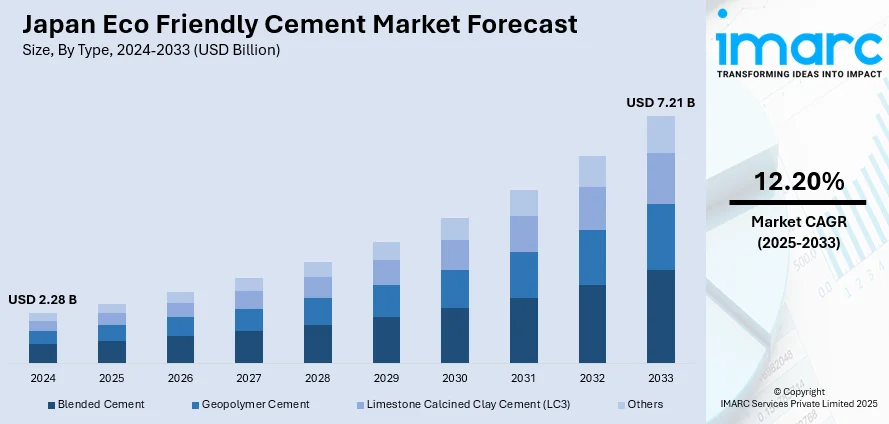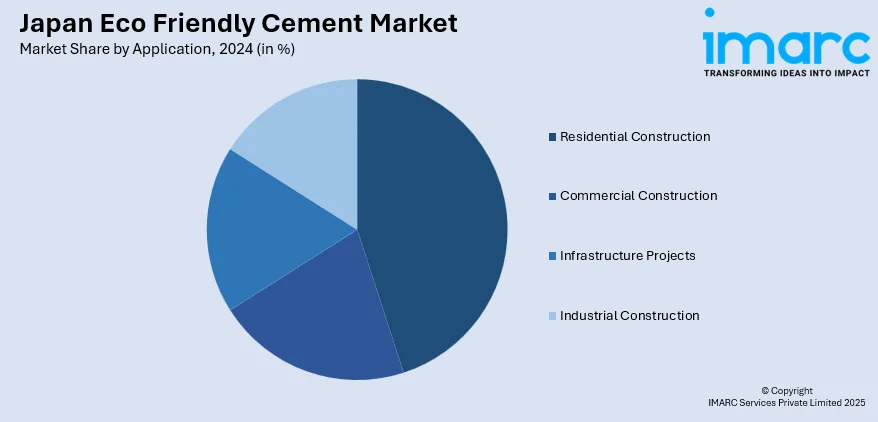
Japan Eco Friendly Cement Market Size, Share, Trends and Forecast by Type, Raw Material, Application, End User, and Region, 2025-2033
Japan Eco Friendly Cement Market Overview:
The Japan eco friendly cement market size reached USD 2.28 Billion in 2024. Looking forward, IMARC Group expects the market to reach USD 7.21 Billion by 2033, exhibiting a growth rate (CAGR) of 12.20% during 2025-2033. The market is driven by stringent environmental regulations, technological innovations, and a national commitment to sustainability. The adoption of green building certifications like CASBEE and the integration of recycled materials in cement production reflect the country's efforts to reduce carbon emissions. These developments are shaping the trajectory of the Japan eco friendly cement market share.
|
Report Attribute
|
Key Statistics
|
|---|---|
|
Base Year
|
2024 |
|
Forecast Years
|
2025-2033
|
|
Historical Years
|
2019-2024
|
| Market Size in 2024 | USD 2.28 Billion |
| Market Forecast in 2033 | USD 7.21 Billion |
| Market Growth Rate 2025-2033 | 12.20% |
Japan Eco Friendly Cement Market Trends:
Government Policies and Green Building Incentives
Japan's government has implemented robust policies to promote sustainable construction, significantly influencing the eco-friendly cement market. Initiatives like the Building Energy Efficiency Act and the Act on Promotion of Global Warming Countermeasures encourage the use of energy-efficient materials. Programs such as the “Flat 35” mortgage offer financial incentives for homes meeting energy efficiency standards, reducing loan burdens for homeowners. Additionally, the Comprehensive Assessment System for Built Environment Efficiency (CASBEE) provides a framework for evaluating building sustainability, further motivating the adoption of eco-friendly materials. These policies not only support environmental goals but also stimulate demand for sustainable building materials, including eco-friendly cement.

Technological Advancements and Material Innovation
Technological innovation is a key factor driving the Japan eco-friendly cement market growth. Advancements in material science have enabled the incorporation of recycled content, like fly ash and industrial by-products, into cement production. Innovations like vacuum insulation panels (VIPs) and aerogels enhance thermal performance, contributing to energy efficiency. In addition, institutions for research are creating cement from things like wood waste, which reduces the carbon footprint of the cement industry. Because of these technological changes, Japan’s green cement is less damaging to the environment and performs better, which aligns with the country’s plans to be sustainable.
Rising Consumer Awareness and Demand for Sustainable Housing
Japanese consumers are increasingly prioritizing environmental sustainability in their housing choices, driving demand for eco-friendly cement. Factors such as frequent natural disasters and a cultural emphasis on harmony with nature influence preferences for resilient and sustainable building materials. The government's promotion of Zero Energy Houses (ZEH) aims to make such homes standard by 2030, reflecting and reinforcing consumer interest in energy-efficient living spaces. This growing awareness and demand encourage builders and developers to adopt eco-friendly cement, which offers benefits like improved insulation and reduced carbon footprints, aligning with both consumer values and national sustainability targets.
Japan Eco Friendly Cement Market Segmentation:
IMARC Group provides an analysis of the key trends in each segment of the market, along with forecasts at the country and regional levels for 2025-2033. Our report has categorized the market based on type, raw material, application, and end user.
Type Insights:
- Blended Cement
- Geopolymer Cement
- Limestone Calcined Clay Cement (LC3)
- Others
The report has provided a detailed breakup and analysis of the market based on the type. This includes blended cement, geopolymer cement, limestone calcined clay cement (LC3), and others.
Raw Material Insights:
- Fly Ash
- Slag
- Silica Fume
- Recycled Aggregates
- Others
A detailed breakup and analysis of the market based on the raw material have also been provided in the report. This includes fly ash, slag, silica fume, recycled aggregates, and others.
Application Insights:

- Residential Construction
- Commercial Construction
- Infrastructure Projects
- Industrial Construction
A detailed breakup and analysis of the market based on the application have also been provided in the report. This includes residential construction, commercial construction, infrastructure projects, and industrial construction.
End User Insights:
- Government and Public Sector
- Private Contractors
- Individual Home Builders
A detailed breakup and analysis of the market based on the end user have also been provided in the report. This includes government and public sector, private contractors, and individual home builders.
Regional Insights:
- Kanto Region
- Kansai/Kinki Region
- Central/ Chubu Region
- Kyushu-Okinawa Region
- Tohoku Region
- Chugoku Region
- Hokkaido Region
- Shikoku Region
The report has also provided a comprehensive analysis of all the major regional markets, which include the Kanto Region, Kansai/Kinki Region, Central/ Chubu Region, Kyushu-Okinawa Region, Tohoku Region, Chugoku Region, Hokkaido Region, and Shikoku Region.
Competitive Landscape:
The market research report has also provided a comprehensive analysis of the competitive landscape. Competitive analysis such as market structure, key player positioning, top winning strategies, competitive dashboard, and company evaluation quadrant has been covered in the report. Also, detailed profiles of all major companies have been provided.
Japan Eco Friendly Cement Market News:
- In January 2025, ITOCHU Corporation declared that it had signed a memorandum of cooperation with MCi Carbon Pty Ltd, an Australian company, and Mitsubishi UBE Cement Corporation. By combining CO2 with waste concrete, steel slag (a by-product of iron-making processes), and minerals like serpentinite, MCi's mineral carbonation technique produces raw materials for concrete and cement substitutes.
Japan Eco Friendly Cement Market Report Coverage:
| Report Features | Details |
|---|---|
| Base Year of the Analysis | 2024 |
| Historical Period | 2019-2024 |
| Forecast Period | 2025-2033 |
| Units | Billion USD |
| Scope of the Report |
Exploration of Historical Trends and Market Outlook, Industry Catalysts and Challenges, Segment-Wise Historical and Future Market Assessment:
|
| Types Covered | Blended Cement, Geopolymer Cement, Limestone Calcined Clay Cement (LC3), Others |
| Raw Materials Covered | Fly Ash, Slag, Silica Fume, Recycled Aggregates, Others |
| Applications Covered | Residential Construction, Commercial Construction, Infrastructure Projects, Industrial Construction |
| End Users Covered | Government and Public Sector, Private Contractors, Individual Home Builders |
| Regions Covered | Kanto Region, Kansai/Kinki Region, Central/ Chubu Region, Kyushu-Okinawa Region, Tohoku Region, Chugoku Region, Hokkaido Region, Shikoku Region |
| Customization Scope | 10% Free Customization |
| Post-Sale Analyst Support | 10-12 Weeks |
| Delivery Format | PDF and Excel through Email (We can also provide the editable version of the report in PPT/Word format on special request) |
Key Questions Answered in This Report:
- How has the Japan eco friendly cement market performed so far and how will it perform in the coming years?
- What is the breakup of the Japan eco friendly cement market on the basis of type?
- What is the breakup of the Japan eco friendly cement market on the basis of raw material?
- What is the breakup of the Japan eco friendly cement market on the basis of application?
- What is the breakup of the Japan eco friendly cement market on the basis of end user?
- What is the breakup of the Japan eco friendly cement market on the basis of region?
- What are the various stages in the value chain of the Japan eco friendly cement market?
- What are the key driving factors and challenges in the Japan eco friendly cement market?
- What is the structure of the Japan eco friendly cement market and who are the key players?
- What is the degree of competition in the Japan eco friendly cement market?
Key Benefits for Stakeholders:
- IMARC’s industry report offers a comprehensive quantitative analysis of various market segments, historical and current market trends, market forecasts, and dynamics of the Japan eco friendly cement market from 2019-2033.
- The research report provides the latest information on the market drivers, challenges, and opportunities in the Japan eco friendly cement market.
- Porter's five forces analysis assist stakeholders in assessing the impact of new entrants, competitive rivalry, supplier power, buyer power, and the threat of substitution. It helps stakeholders to analyze the level of competition within the Japan eco friendly cement industry and its attractiveness.
- Competitive landscape allows stakeholders to understand their competitive environment and provides an insight into the current positions of key players in the market.
Need more help?
- Speak to our experienced analysts for insights on the current market scenarios.
- Include additional segments and countries to customize the report as per your requirement.
- Gain an unparalleled competitive advantage in your domain by understanding how to utilize the report and positively impacting your operations and revenue.
- For further assistance, please connect with our analysts.
 Request Customization
Request Customization
 Speak to an Analyst
Speak to an Analyst
 Request Brochure
Request Brochure
 Inquire Before Buying
Inquire Before Buying




.webp)




.webp)












